 |
This task shows you how to insert a plunge
milling
by offset operation into the program.
See also Plunge Milling with Points.
To create the operation you define::
- the
geometry of the part to machine
 , ,
- The operation takes into account the geometrical environment and
thus accepts the definition of the part and the definition of the rough
stock.
- If the rough stock is not defined, the operation uses the rework
technology
in order to take into account the shape of the stock at the
beginning of the operation
- the
tool to use
 : :
- Center cutting plungers,
- Side plunging milling cutters.
- the parameters of the
machining
strategy
 , ,
- the feedrates and spindle speeds
 , ,
- the macros
 . .
Only the geometry (part, points and contours) is obligatory, all of the other requirements have a
default value. For more information on the parameters, please refer to
Plunge Milling Parameters. |
 |
Either:
- make the Manufacturing Program current in the specification
tree if you want to define an operation
and the part/area to machine at the same time,
- or select a machining feature from the
list if you have already defined the area to machine and
now you want to define the operation to apply to it.
Below we are going to see how to do the first of these and how to define
an user grid.
Open file
Plunge2.CATPart from the samples directory. |

|
-
Click Plunge Milling
 in the Roughing Operations sub-toolbar.
in the Roughing Operations sub-toolbar.
A entity and a default tool are added to the program.
The dialog box opens at the geometry tab page
 . .
This page includes a sensitive icon to help you specify the geometry to be
machined.

The area that represents the part geometry is colored red indicating that
the geometry is required
for defining the area to machine.
-
Click the red area representing the part in the
sensitive icon and select the part in the viewer.
Then double-click anywhere in the viewer to confirm your selection and
redisplay the dialog box.

-
Click the red area representing the rough stock in the
sensitive icon and select the rough-stock as shown below.
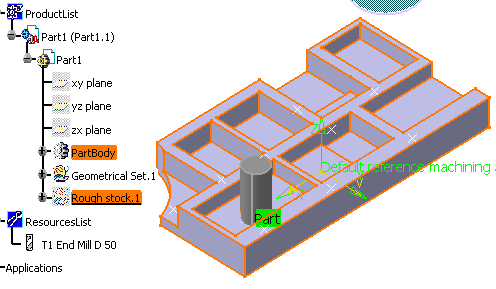
-
Go to the Machining Strategy tab..
Select By Offset as the Grid type.
The dialog box changes to this:
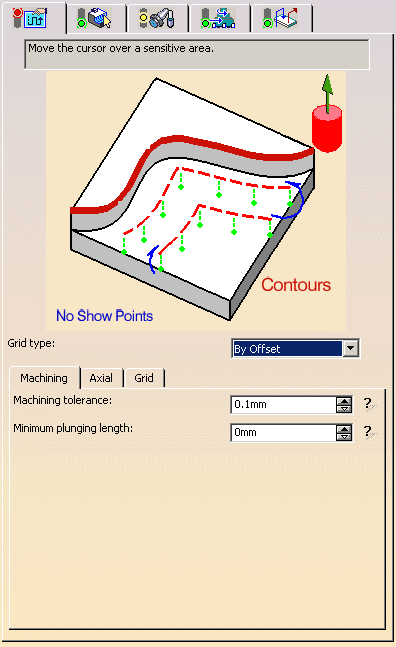
-
Click the red curve in the sensitive icon and select a
contour in the 3D Viewer.
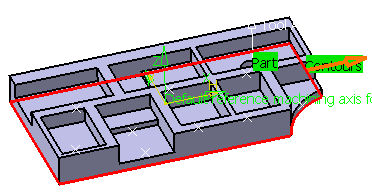
-
Go to the tool tab  and change the tool diameter to 20:
and change the tool diameter to 20:
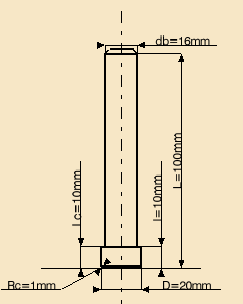
-
Click Tool Path Replay
 . .
A progress indicator is displayed. You can cancel the tool path
computation at any moment before 100% completion.
The tool path is displayed.
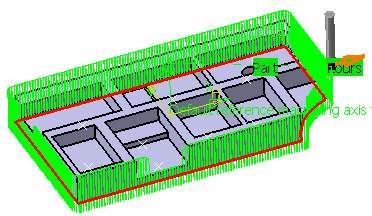
Click OK in the Plunge milling.1 dialog box, and
OK in the main dialog box to validate and exit the dialog
box.
-
Create a new plunging by offset operation, with the
following contour:

-
Click Tool Path Replay
 . .
The tool path is displayed.
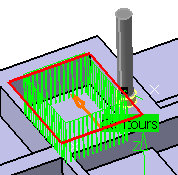
-
Go to the Grid tab and increase Contour
Number to 6.

Click Tool Path Replay
 . .
The tool path is displayed.
-
If you play the Video from last save result,
you see:

Go to the Grid tab and decrease the Finished cutting
progress value to 1mm. Click Tool Path Replay and then
play the Video from last save result again.
This results in:
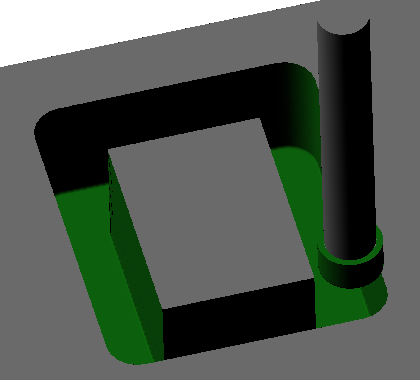
-
Click OK in the Plunge milling.1
dialog box, and OK in the main dialog box to validate and exit
the dialog box.
|
 |
Invalid Face
-
If a tool path cannot be computed because of invalid
faces,
an explicit warning message like this one will appear:

Each invalid face is highlighted in red, with an arrow
pointing on it.
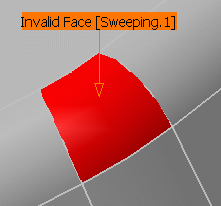
This visualization is removed when you close the main
dialog box or
when you select Remove in the contextual menu.

-
Click OK in the Warning box to revert to the
main dialog box.
In the Geometry tab, a message Ignore invalid faces: No
is displayed:
-
You can either:
- close the dialog box.
When you reopen it, the Ignore invalid faces: No will not
be displayed.
- heal the defective geometry and restart the computation.
If it is successful the message Ignore invalid faces: No
will disappear.
- ignore the invalid faces. Click the text Ignore invalid
faces: No.
It will turn to Ignore invalid faces: Yes and the
computation will continue.
The message remains displayed as a warning.
|
|
 |
Be very careful when you choose to ignore invalid faces.
We recommend that you ignore only faces that will not affect the tool path.
Otherwise this may lead to defective tool paths. |